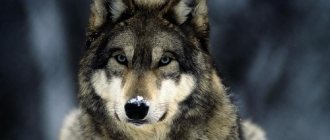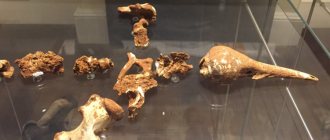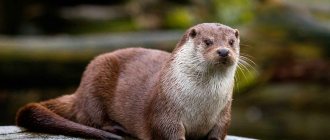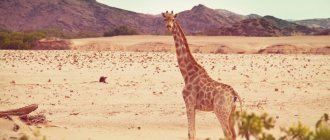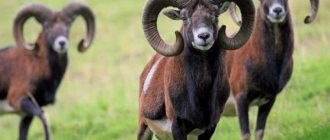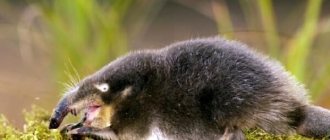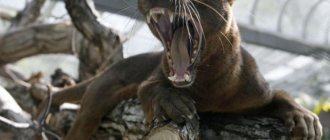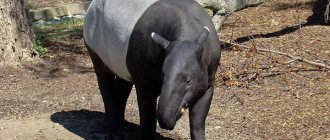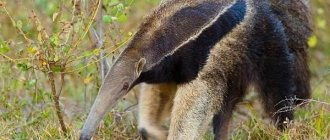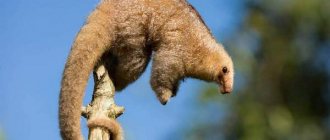Koalas are marsupials that live in Australia. The name of this unique species in its family comes from the Darak word “gulawan” or “gula”, which gradually became “koola”. One of the assumptions for the translation of this term is: “the one who does not drink.” The species term "cinereus" is Latin for "ashen" and has been in use for about two centuries.
English-speaking settlers at the end of the 18th century began to call these animals koala bears ("koala bear"), since in appearance they look a little like small bear cubs. This name has spread beyond Australia, but it does not correspond to reality - koalas are not related to bears.
Description and origin of the species
Europeans first discovered the animal in 1798, during an expedition to the Blue Mountains. The first image of the animal was published by the British naturalist George Perry in 1810. The first scientific description of the animal was given by the British botanist Robert Brown in 1814, although his work remained unpublished for a long time.
In 1817 the animal was given the scientific name Phascolarctos cinereus. The word phascolarctos is formed from two Greek words phaskolos
(bag) and
arktos
(bear), and literally means marsupial bear. Cinereus is translated from Latin as “ash-colored.”
The word "koala" was borrowed from the Darak language of the Australian Aboriginal people. The original name of the animal is gula,
literally meant “without water.” The aborigines thought that the animals did not drink water, since the animals came down from the trees quite rarely and drank only at night. The first European colonists often called the animal "koala bear", that is, koala bear, due to its external resemblance to a bear.
The koala's closest relative is the wombat. Both families belong to the order Dvureztsova, suborder Vombatiformes,
and are the only surviving representatives of this suborder. More distant relatives of the animal - kangaroos and possums, belong to two other suborders of the Dvureztsov family.
Koala: history of the development of the species
If you look at a photo of a koala, you can see that the animal resembles a toy bear with soft fur, but has nothing to do with it. In fact, koalas belong to the order of marsupials, but they are the only ones from the koala family.
Koalas are lazy and friendly, so they are quite peaceful with people. It is believed that several subspecies of koalas once lived in Australia, but they all became extinct. By the way, today’s koalas might also not exist because of poachers who liked the animals’ fur too much. Fortunately, no misfortune happened, and we can see koalas in our time.
Since koalas come from Australia, their appearance is certainly associated with legends - this is the custom among the aborigines. One of the most popular stories explains the lack of water in the diet of koalas.
Photo: pixabay.com: UGC
Legend has it that once upon a time there lived in the tribe an orphan boy whose name was Kub-Bor (translated as 'marsupial bear'). The boy was often offended, and therefore he was forced to take care of himself.
At that time there was very little water in Australia, so Kub-Bor was constantly thirsty. And then one day, when the adults went hunting, the young man drank all the water that was freely available. Realizing what he would get for this, Kub-Bor ran into the forest, hid on a small tree and prayed for it to grow.
Higher powers heard the boy - soon he was sitting on a huge eucalyptus tree. However, this did not save him from punishment: the adults quickly found the boy. One of the tribe members was able to climb a tree and throw Cub-Bora down.
What a surprise the adults were when the baby did not crash, but turned into a cute bear cub. The koala quickly climbed up and strictly forbade people to approach his species, threatening to send a drought to the earth. People obeyed, and the koalas were not touched again. And they, in turn, did not need water from that time on.
If we talk about the version of scientists, they believe that koalas appeared more than 30 million years ago, but the modern species has lived on earth for about 15 million years. Europeans learned about koalas around the beginning of the 19th century when they found their remains.
What does a koala look like?
The koala is a strongly built, stocky, medium-sized animal that looks a bit like a lop-eared bear cub. The head is large, the tail is either vestigial or absent. The animal weighs from 4 to 15 kg, with a body length of 60 to 85 cm, which makes it one of the largest terrestrial marsupials. The size of the animal varies greatly depending on its habitat. Koalas living in Victoria weigh about twice as much as their counterparts in Queensland.
Sexual dimorphism is highly pronounced - males are approximately 1.5 times larger than females. Males can also be identified by their more rounded nose, and by their mammary glands, hairless areas of skin on the chest. Like most other marsupials, males have a bifurcated penis, females have 2 lateral vaginas and 2 separate uteruses. Females also have a pouch, the entrance to which is tightened by the sphincter to prevent the baby from falling out.
The koala has thick, long fur on its back and shorter fur on its belly. Color varies from light gray to chocolate brown. The belly fur is usually white or light gray in color and may reflect the sun's rays. Koala fur has the best thermal insulation properties among marsupials, and perfectly protects the animal from rain and wind.
The animal has a strong, muscular body and disproportionately long front legs. Sharp curved claws help the animal climb trees. The front paws have 2 opposite toes out of 5 (first and second), thanks to which the animal easily clings to branches. There is a cartilaginous cushion at the end of the spine to make it more comfortable for the animal to sit on the branch.
The koala's brain is one of the smallest in proportion to body weight among all animals, about 60% smaller than that of other representatives of the order Dvureztsov. On average, the animal's brain weighs only 19 grams and has a primitive structure. Scientists attribute the low brain weight to a plant-based diet, on which maintaining a larger brain would be impossible. The brain occupies only 61% of the volume of the cranium, the rest of the space is filled with cerebrospinal fluid, which is probably due to the need for shock absorption in the event of an animal falling from a tree.
Due to its small brain, the animal is not very smart and does not adapt well to changes. For example, a koala often does not eat leaves that have already been plucked from a branch, since the animal cannot adapt to changes in the feeding procedure. Koalas have good sense of smell and hearing, but poor eyesight.
Nutrition
Such animals can eat almost only one plant in the world - eucalyptus. They eat its shoots and leaves. But this representative of the flora contains insufficient protein, but in excess it is full of harmful, even toxic substances and elements.
And there are so many of the latter components that their dose is quite capable of exceeding the permissible limit, leading to death. It should be noted that many of the animal species would definitely not be able to survive on such a diet. But how can koalas not get poisoned with such a diet?
The secret is that they choose only certain types of their favorite eucalyptus trees as food. And this is not an easy task at all. Their highly developed sense of smell helps koalas distinguish a poisonous plant from others.
For this reason, keeping a domestic koala , even despite the peaceful, sedentary nature of this animal and very pretty appearance, is quite difficult. Of the eight hundred varieties of eucalyptus trees, they are able to feed on less than a sixth of them without harming their own body.
But in captivity, such choice is significantly reduced. The owners, being human, do not have sufficiently developed senses and knowledge to provide their pets with nutritious food. Therefore, koalas, forced from hunger to eat anything, are often poisoned to death.
The slowness of these animals should also be explained by their feeding habits. As already mentioned, their diet does not contain enough protein. Hence the very slow metabolism due to the low nutritional value of the foods consumed.
This animal requires about a kilogram of eucalyptus leaves per day, which it carefully crushes with its teeth, which in all respects are adapted specifically for this type of food. The koala also obtains the moisture required for the body from its favorite plant, as well as the dew that forms on it.
Where does the koala live?
The animal is found in the southeast and east of Australia. The animal's habitat occupies about 1 million square kilometers and passes through the states:
- northeast, central and southeast Queensland;
- eastern New South Wales;
- Victoria;
- southeast of South Australia.
Animals were also brought near Adelaide, and to Kangaroo and French Islands, where the animals successfully took root. Previously, the animal's habitat extended far to the west, to the southwestern part of Western Australia, but climate change and active hunting by people squeezed the animals out of most of their historical habitat.
Koalas live in dense forests and woodlands, in tropical and temperate climates. In arid areas, animals try to stick to the coastal area in order to cool off in a river or stream during extreme heat.
What does a koala eat?
The koala is a herbivore and feeds mainly on tree leaves.
- The majority of the diet consists of eucalyptus leaves. Animals eat about 30 species of the more than 600 species of eucalyptus.
- Koalas also eat the leaves of other trees - acacia, allocasuarina, callitris, leptospermum and tea tree.
Because eucalyptus leaves contain a lot of water, the koala drinks relatively little liquid. An animal needs from 70 to 90 ml of water per 1 kg of live weight per day. Females can get by on leaves only, but large males need additional water.
During feeding, the animal holds on to the branches with its hind paws and one front paw, and plucks leaves with the other front paw. Small individuals can move to the end of the branch, large animals stay on thick branches. The animal eats up to 400 grams of leaves per day, in 4-6 meals. Due to the scarce fat reserves, the animal must eat frequently.
The animal is well adapted to the low-calorie and toxic diet of eucalyptus. The koala uses on average 2 times less energy than other mammals and successfully digests toxins from eucalyptus thanks to the cytochrome P450 enzyme in the liver.
The animal has only one section of the digestive tract, about 2 meters long, which is proportionately larger than that of any other animal. The digestive process lasts about 100 hours in the wild, and at least 200 hours for animals living in captivity.
Interesting Facts
Koalas are amazing and unlike any other animals. Their behavior and lifestyle are practically unparalleled.
Interesting Facts:
- Koalas are the only representatives of the genus and are not divided into subspecies or groups.
- Southern koalas are larger than northern ones.
- You can distinguish a male from a female by the overall size of the body and the size of the ears. The male has smaller ears.
- Koalas eat only eucalyptus, but carefully choose the least toxic species. Animals have a very large liver, which is capable of neutralizing poisons contained in plant sap.
- The paw pads have a unique pattern (print) so they can be identified just like humans. In the wild, besides the koala, only monkeys can boast of unique prints.
- The weight of the brain is no more than 0.2% of the total weight. Scientists believe that poor plant food contributed to the decrease in volume.
- It is not recommended to keep koalas in captivity, since they do not eat anything other than fresh eucalyptus leaves.
- After small koalas stop drinking milk, the female begins to eat her excrement. This diet helps the cubs adapt to new food and toxins that eucalyptus leaves contain.
- If animals lack vitamins and minerals, they eat soil.
- Koalas practically do not drink, getting moisture from the juice of the leaves and licking the dew. Animals can go to water only in case of drought or during illness.
- Despite their funny appearance, koalas can be dangerous opponents. In the fight for females, males grab each other's fur and scratch opponents with their claws.
- The koala has a slow metabolism, which determines its lifestyle. Only sloths can compete with the koala in slowness.
- A koala's pregnancy lasts about 30 days, after which the newborn cub moves through the mother's fur into the pouch. The baby grows and develops in the pouch for up to six months, and then moves onto the female’s back.
- During feeding, koalas do not swallow the last chewed batch of leaves, but hide them behind their cheek. This “stash” is intended for a snack during the daytime sleep. The animal wakes up, swallows the pulp and falls asleep again.
- Females, unlike males, rarely leave their territory and protect their area from encroachment. Males usually do not have a clear location and move between the areas of females.
- Grown-up females leave their mother at one or one and a half years of age. Males mature much longer, so they can live next to their mother for up to two or four years.
- Males have a bifurcated penis, while females have two vaginas and two uteruses. This structure of the genital organs is characteristic of all marsupials.
- In Australia, vines are stretched over roads so that animals can easily move over the road. Also in areas where koalas live, there are road signs that limit the speed of movement and warn drivers that animals may enter the road.
- Koalas spend about 8 hours searching for food in the evening or at night. The rest of the day they just sleep.
Character and lifestyle
Since animals receive little energy from food, animals lead an energy-saving lifestyle, sleeping or resting about 20 hours a day. Koalas are active at night and spend most of their waking hours eating. During the day, the animals sleep on the same tree where they eat. Animals descend to the ground only to move to another tree.
When resting, koalas rest on the trunk with their backs, or lie on their stomachs on a branch with their paws hanging down. On hot days, the animals go lower, to the coldest part of the tree, and hug the trunk to cool down. In cold weather, animals curl up into a ball to conserve heat. During periods of strong wind, animals choose lower and thicker branches as more stable.
Social structure
Koalas live alone and spend no more than 15 minutes a day communicating with their relatives. Females lead a sedentary lifestyle - each adult female usually has her own territory. Adult males, on the contrary, often change their place of residence. Alpha males dominate younger and smaller opponents, and occupy the best territories near fertile females. Younger and weaker males are forced to travel frequently in search of territory and females that they can fight off from the dominant male. Alpha males also sometimes venture outside their home range to expand their territory.
To mark their trees, males rub their chest gland against a tree trunk or branch, or urinate on it. Before climbing a tree, koalas always sniff it in search of scent marks.
Conflicts between animals most often occur when animals meet on the same tree. In a fight, the animals bite, push and kick. The larger koala tries to push the enemy out of the tree, or drives him into a corner and bites him. When a rival is driven from a tree, the winner celebrates the victory with a roar and marks the tree as his own.
This is how koalas fight.
In the process, both opponents strive to push their opponent out of the tree.
In the video below, the larger male chases the young koala out of the tree, and the poor thing sits under the tree and cries loudly.
Pregnant and lactating females are usually more aggressive and will attack anyone who gets too close.
How do koalas communicate with each other?
Koalas communicate with each other with a loud roar - it sounds like a cross between snoring, growling and grunting. Just listen.
The animal's unique vocal cords allow it to roar at a low frequency, allowing the vibration of the roar to travel far through dense vegetation. Koalas roar at any time of the year, especially often during mating season. Males roar to attract females, scare away other males and mark their own territory.
By sound, animals can approximately determine the size of the owner of the voice, so females more often respond to the roar of larger males, and young males try to bypass an obviously stronger opponent.
Females roar softer, and during defense or stress they also make other sounds - squeals, screams, growls. Young koalas squeak when in danger; with age, the squeak turns into a roar or roar. Koalas change their facial expressions depending on their mood. When animals scream, they press their ears back. When animals growl or squeak, the ears tilt forward and the upper lip rises, exposing the teeth.
Fluffy lazy people
Koalas prefer a solitary lifestyle and live in their chosen territories for quite a long time. Animals gather in small groups consisting of a male and several females only during the breeding season.
These fluffy lazy people can remain motionless for up to 18 hours a day, and they sleep in trees, tightly grasping a branch or trunk with their front paws or sitting comfortably in the forks.
As a rule, koalas are active at night. At this time, the animal slowly moves from one tree to another in search of food. Despite their external clumsiness, koalas quite deftly jump from one tree to another. They descend to the ground only if they are unable to jump to the selected tree.
Koala breeding
The mating season for koalas lasts from mid-spring to early autumn. During estrus, females throw their heads back and experience tremors and spasms. However, males are unable to tell when a female is in heat and often mate with out-of-estrus females against their will. In response, the females fight back and sometimes even fall from the trees, but since the males are much larger, the female rarely manages to fight back. If several males claim a female, they fight among themselves, and then the female goes to the winner.
Pregnancy lasts from 33 to 35 days. One litter usually produces one, sometimes two, cubs. Like other marsupials, babies are born as embryos, weighing only 0.5 grams, but with a developed mouth, fingers, limbs, and functioning digestive and respiratory systems. After birth, the baby crawls into its mother's pouch, which will become its home for the next few months.
Baby koalas
At 7 weeks, pigmentation appears in the baby, and it becomes possible to determine the sex of the baby. From 13 weeks, baby koalas' eyes open and fur begins to grow. At this time, the weight of the animal is about 50 grams. At 26 weeks, the cub is already completely covered in fur, looks like an adult, and begins to poke its head out of the pouch.
From 6 months, the mother gradually switches the baby to feeding on leaves. For about 1 month, the female digests the leaves herself, the calf then eats the digested leaves from the mother's cloaca. The composition of fermented leaves differs from ordinary excrement, and is more reminiscent of intestinal contents, with a large number of digestive bacteria. The koala has very low-calorie milk compared to other animals, but the low nutritional value is compensated by long lactation - the mother feeds the baby milk for up to 12 months.
At the age of 6-7 months, the cub first emerges from the pouch, but stays close to its mother. At this time, the baby already weighs about 300-500 grams. By 9 months, the young koala already weighs about 1 kg, has fully grown fur and leaves the pouch forever. Instead, the grown cub moves on the mother's back, and little by little learns to climb trees on its own.
By 12 months, the mother stops breastfeeding and the baby spends more and more time alone. As soon as the mother becomes pregnant again, her connection with the grown cub is abruptly cut off. The female aggressively drives the weaned cub away from her territory, motivating it to search for its own territory.
Females reach sexual maturity at 3 years of age, males mature later, at about 4 years of age. Since raising a young takes about 1 year, females typically give birth once every 2 years. In favorable conditions, with an abundance of food, females can give birth every year.
Types of koalas
Historically, researchers have identified 3 subspecies based on the animal’s habitat:
- Queensland koala ( P. c. adustus
) - New South Wales koala ( P. cinereus
) - Victoria koala ( P. c. victor
)
The Queensland koala is the smallest of all, with short, silvery fur and a small head. The Victorian koala is the largest subspecies, with long brown fur and a wider skull.
According to recent studies, the 3 subspecies do not have genetic differences among themselves, but represent populations separate from each other, that is, it turns out that in fact the animal does not have subspecies. The differences are explained by the fact that animals from different areas rarely interbreed with individuals from other populations, which leads to inbreeding and limited genetic diversity.
Population and protection of the species
The koala is listed in the Red Book with the status of a species under threat of destruction. The total number of animals, according to various estimates, varies from 100,000 to 200,000 individuals.
The main threats to the population are:
Diseases
Animals suffer from the KoRV immunodeficiency virus, which acts similar to human HIV. Northern populations are almost completely infected with it, while animals in southern Australia are still free from this virus.
Forest fires
The animals are very slow, and when there is a fire, the animals instinctively climb up the trunk. In addition, eucalyptus trees are highly flammable, so forest fires cause enormous harm to the population. During bushfires in the summer of 2019-2020 in New South Wales, about 8,400 animals died, this is about 30% of the state's population. About 30,000 koalas died in the Kangaroo Island fires, out of a total population of about 50,000.
Droughts
During drought, eucalyptus leaves fall and animals suffer from hunger, dehydration and overheating. Mostly young koalas die, as older and stronger individuals push the young away from sources of food and water. In 1980, due to an abnormally severe drought in Queensland, 63% of the population died. The number of animals in Queensland later declined even further, from 59,000 animals in 1995 to 11,600 animals in 2009, due to several abnormally dry seasons in 2002-2007.
Climate change
Global warming means a drier, hotter climate in Australia, which means bushfires, drought, hunger and thirst for koalas. Over time, the habitat of the animals will shrink even further, and the animals will remain only in areas with a more temperate climate. In addition, an increase in carbon dioxide in the atmosphere changes the composition of eucalyptus leaves: the protein content decreases, the tannin concentration increases, so the leaves become less nutritious.
Range reduction and fragmentation
Urbanization, expansion of agricultural land, deforestation and road construction are reducing and fragmenting the animal's natural habitat.
Australian Aborigines hunted animals for meat, but within reasonable limits. At the beginning of the 20th century, European settlers massacred the animals for their thick, beautiful fur. In 1924 Australia exported more than 2 million skins. In 1915, 1917 and 1919, more than 1 million animals were killed per year. Since the 1930s, Australians have been thinking about protecting the species, after only 500-1000 individuals remained in Victoria in 1934.
To preserve the population, Australians have opened new national parks, and regularly release animals into the wild in new places. In particular, the animals were brought to the Kangaroo and French Islands, where they successfully took root, and to Quail Island, where they ate all the eucalyptus trees. From 1923 to 2006, in Victoria alone, more than 250,000 animals were transported and released into the wild in more than 250 new locations.
Natural enemies
Recommended by topic
Sable Toucan Tit
In their natural environment, koalas have no enemies. Most predatory representatives of Australia simply disdain to eat an animal that “smells” of eucalyptus. Koalas eat the leaves and shoots of toxic trees all their lives, so in addition to the unpleasant odor that permeates the fur, entrails and meat of animals, the remains of unprocessed toxins accumulate in their bodies. Thus, predators can become poisoned when eating a koala.
There have been only a few cases of attacks on koalas by predatory animals. But wild dogs did not eat the carcass of the killed animal, so scientists came to the conclusion that they hunted not for food, but for pampering.
The koala population is greatly influenced by human activities and natural disasters. Slow animals cannot escape from fire and smoke, so they die en masse during fires.
Koalas die en masse on highways and roads because they cannot escape from a car.
Poor ecology also has a detrimental effect on the number of koalas. Environmental pollution leads to the accumulation of toxins in leaves and shoots. Animals eat greens and die from poisoning.
Cutting down eucalyptus groves also causes great harm to the population. Animals migrate to other areas, die along the way under the wheels of cars or die of hunger.

